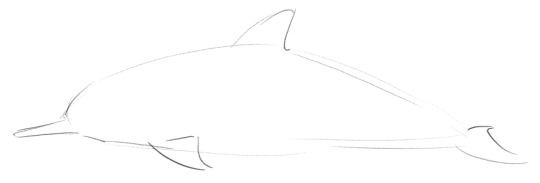#so many projeeccctttssss
Explore tagged Tumblr posts
Note
Do you have any advice on how to begin drawing a cetacean? When I'm drawing terrestrial animals, I can break them down into simpler shapes pretty easily, but cetaceans are just Big Tubes and I'm completely stumped on how to start
(Disclaimer that my work is rather stylised, so I'm not looking for advice on photorealism! Just any advice you have in general. I admire your ability to understand and render these sausage-bodied beasts)
Hi! That's an interesting question. I have to admit I had to draw a couple of dolphins first to see how I actually deal with them when free-handing lol. So much of my work as of late is scientific illustration, where in many cases I can build upon my own older illustrations. The new pieces are always 100% new, but correcting a base - however poor - is easier than starting from scratch.
Before I go any further let me stress the eternal importance of references. I can draw a dolphin fine from memory but for it to be actually accurate I need references. I always use them. Especially when it comes to weird poses or angles, but even for illustrations I will reference 25-50 photographs. Use them, study them, find them. They are a resource not a cheat.
Also, years ago I actually started work on a whole series of dolphin drawing tutorials. Or rather, collections of notes and tips for different topics (anatomy, differences between males and females, colouration, variation). Looking at the files now I see I had actually written and drawn a frightening amount already. Perhaps I should try to finish them? Is that something people would be interested in? Anyway, it starts off with a word of encouragement, which I do want to share here:

Actual advice is below the cut:
ONTO METHODS - illustrations
I found that for me, my method depends on whether I'm making an illustration or a full scene painting. For illustrations - which are in flat side view - I actually embrace the sausage. I drew a dolphin for you and saved the steps of how I go about it.

And this is the first. I start with a sort of flat-bottomed airfoil shape, and then add fins and a beak in approximate locations.

Next is refining the appendages and giving a face. Shape and placement of appendages as well as eye and mouth line is all experience and/or reference work.

Then comes fixing what I messed up lol. I always make the head too big first try (would have been good for a baby dolphin though!). Using cutting/transforming/moving selections around I correct proportions to what feels correct to me (again, that part comes from having seen and drawn a lot of dolphins).

Add some markings and hooray we have a spinner dolphin! This is the part where I would seriously start consulting references to check all the details and proportions are in order. If you don't need (photo)realism you can skip that step and use refs further back in the process just to get the shape/idea/colour of the species you're trying to paint right.
MORE METHODS - for different poses
When it comes to dynamic poses, my workflow is completely different. I just start from the nose and build my dolphin from there. Because as said above, they do have anatomy. And I think the way the beak flows into the cheek, the eye bumps connect, then the curve of the throat, the attachment of the pectoral fin, the way the belly curved up towards the genital region, the slight bulge behind that, then the muscles of the peduncle which flow into the flukes - I think the relations between those separate parts are enough for me?

These are the little dolphins (and a porpoise) I sketched from memory. In all cases I started from the tip of the nose and built from there, with minimal or no adjustments/erasing along the way. It was very much outline work. Details on eyes, mouth, etc, would come later. The killer whale is a bit different and got way more detailed than the rest. With such a front view angle I do use some spherical shapes to break it down for the body and face.
Otherwise I've never really liked or used the method of breaking an animal down into shapes, it never felt logical or intuitive to me. My "method" (if you can call it that lol) just comes from having drawn a lot of dolphins. I don't know if it is necessarily helpful when you want to get a grasp of them when starting out. Regardless I do hope this answered your question somewhat and you could get something useful out of it!
Also, I realise now I mostly talked about "standard "dolphins - for whales/short-beaked smaller cetaceans/etc my process is mostly the same, except their heads just have different shapes.
#namtalk#tutorial#sort of?#i always wish I had a clearer answer to these kinds of questions!#but i do hope this is still helpful#seeing those old tutorials also really makes me want to finish them#so many projeeccctttssss
35 notes
·
View notes